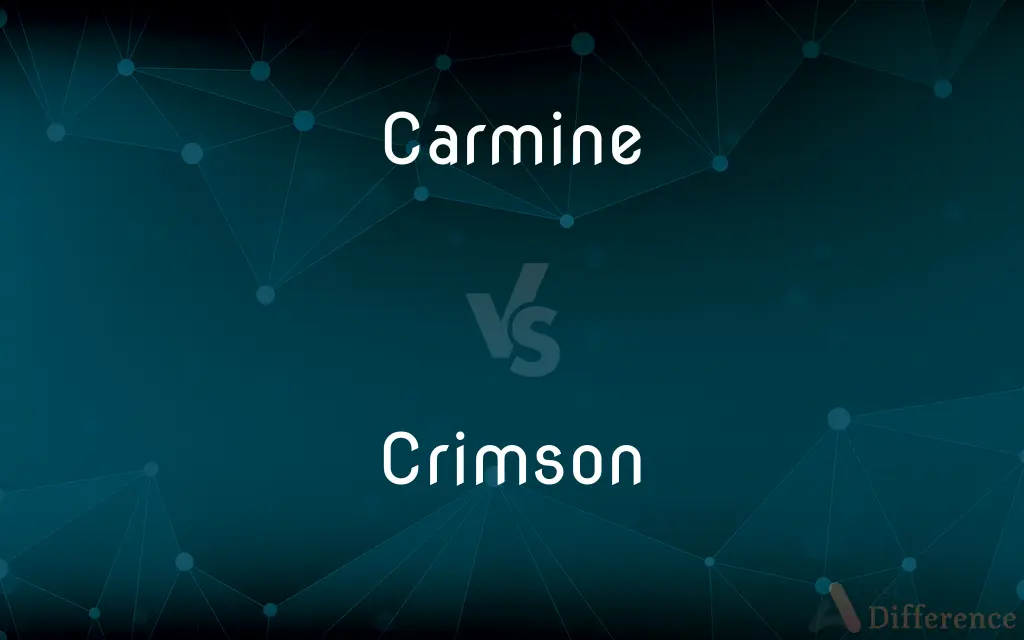Carmine vs. Crimson — What's the Difference?
By Tayyaba Rehman — Updated on October 29, 2023
Carmine is a vivid red dye derived from insects, while crimson is a deep, purplish-red color. Both refer to shades of red but have different origins and hues.

Difference Between Carmine and Crimson
Table of Contents
ADVERTISEMENT
Key Differences
Carmine and crimson are both terms that denote specific shades of red, yet their origins and the nuances in their colors set them apart. Carmine is a bright red hue, often leaning slightly toward the pink or purple spectrum. This color is derived from a dye produced by the cochineal insect, which is found predominantly in Central and South America. The use of carmine as a dye dates back centuries and has applications in various fields, from art to cosmetics.
Crimson, on the other hand, stands as a deeper, more purplish-red color. Unlike carmine, the term 'crimson' does not trace its roots to a specific source or method of production. The name is more indicative of the shade itself, a rich and dark variant of red. Historically, crimson was associated with the dye obtained from the kermes insect, which was used long before the introduction of cochineal.
Another noteworthy distinction between carmine and crimson is their cultural significance and use. Carmine has a long-standing history in art, having been used by artists for its vibrant and lasting color. This hue has also found its place in the cosmetic industry, particularly in lipsticks and blushes.
In contrast, crimson holds symbolic meanings in various cultures and contexts. In Western traditions, for example, crimson often denotes wealth, power, or religious significance. This deep red has been a favored color for robes, flags, and academic regalia, symbolizing various forms of prestige.
Comparison Chart
Origin
Derived from cochineal insect.
Historically from kermes insect.
ADVERTISEMENT
Hue
Bright red, can lean slightly pinkish or purplish.
Deep, purplish-red.
Historical Use
Used in art and cosmetics.
Symbolizes wealth, power, religion.
Source
Natural dye from insects.
Varies; often synthetic dyes today.
Cultural Significance
Often used in art and makeup.
Associated with prestige.
Compare with Definitions
Carmine
A vivid red color.
The sunset painted the sky in shades of carmine.
Crimson
A deep purplish-red color.
The velvet curtains were a rich crimson.
Carmine
A dye derived from the cochineal insect.
The traditional textile was colored using carmine dye.
Crimson
Historically derived from the kermes insect.
Ancient robes were dyed in brilliant crimson.
Carmine
Often associated with artistic applications.
The painter preferred carmine for its vibrant shades.
Crimson
Common in academic and religious regalia.
Graduates wore crimson-colored gowns.
Carmine
Used in cosmetics and food coloring.
Her lipstick had a distinct carmine hue.
Crimson
Crimson is a rich, deep red color, inclining to purple. It originally meant the color of the kermes dye produced from a scale insect, Kermes vermilio, but the name is now sometimes also used as a generic term for slightly bluish-red colors that are between red and rose.
Carmine
Natural in origin.
Carmine dye is sourced from nature, specifically insects.
Crimson
Of a rich deep red colour inclining to purple
She blushed crimson with embarrassment
Carmine
Carmine ( or ), also called cochineal (for the insect from which it is extracted), cochineal extract, crimson lake or carmine lake, natural red 4, C.I. 75470, or E120, is a pigment of a bright-red color obtained from the aluminium complex derived from carminic acid. It is also a general term for a particularly deep-red color.
Crimson
A rich deep red colour inclining to purple
A pair of corduroy trousers in livid crimson, they were horrid to behold
Carmine
A vivid crimson colour
Carmine roses
Crimson
(of a person's face) become flushed, especially through embarrassment
My face crimsoned and my hands began to shake
Carmine
A strong to vivid red.
Crimson
A deep to vivid purplish red to vivid red.
Carmine
A crimson pigment derived from cochineal.
Crimson
To make or become deeply or vividly red.
Carmine
Strong to vivid red.
Crimson
A deep, slightly bluish red.
Carmine
A purplish-red pigment, made from dye obtained from the cochineal beetle; carminic acid or any of its derivatives.
Crimson
Having a deep red colour.
Carmine
A purplish-red colour, resembling that pigment.
Crimson
Immodest. en
Carmine
Of the purplish red colour shade carmine.
Crimson
(intransitive) To become crimson or deep red; to blush.
Carmine
A rich red or crimson color with a shade of purple.
Crimson
(transitive) To dye with crimson or deep red; to redden.
Carmine
A beautiful pigment, or a lake, of this color, prepared from cochineal, and used in miniature painting.
Crimson
A deep red color tinged with blue; also, red color in general.
Though your sins be as scarlet, they shall be as white as snow; though they be red like crimson, they shall be as wool.
A maid yet rosed over with the virgin crimson of modesty.
Carmine
The essential coloring principle of cochineal, extracted as a purple-red amorphous mass. It is a glucoside and possesses acid properties; - hence called also carminic acid.
Crimson
Of a deep red color tinged with blue; deep red.
The blushing poppy with a crimson hue.
Carmine
A variable color averaging a vivid red
Crimson
To dye with crimson or deep red; to redden.
Signed in thy spoil and crimsoned in thy lethe.
Carmine
Color carmine
Crimson
To become crimson; to blush.
Ancient towers . . . beginning to crimson with the radiant luster of a cloudless July morning.
Carmine
Having any of numerous bright or strong colors reminiscent of the color of blood or cherries or tomatoes or rubies
Crimson
A deep and vivid red
Crimson
Turn red, as if in embarrassment or shame;
The girl blushed when a young man whistled as she walked by
Crimson
Having any of numerous bright or strong colors reminiscent of the color of blood or cherries or tomatoes or rubies
Crimson
Characterized by violence or bloodshed;
Writes of crimson deeds and barbaric days
Fann'd by Conquest's crimson wing
Convulsed with red rage
Crimson
(especially of the face) reddened or suffused with or as if with blood from emotion or exertion;
Crimson with fury
Turned red from exertion
With puffy reddened eyes
Red-faced and violent
Flushed (or crimson) with embarrassment
Crimson
Symbolic of wealth and power.
The king wore a crimson cloak.
Crimson
Represents passion or intensity.
His face turned crimson with embarrassment.
Common Curiosities
Can carmine be found in food?
Yes, carmine is sometimes used as a food coloring.
Are there ethical concerns with using carmine?
Some raise ethical concerns since carmine is derived from insects, impacting vegan or cruelty-free choices.
Can crimson be used to describe emotions?
Yes, someone might be described as "crimson with rage" or "crimson with embarrassment."
Is carmine a natural color?
Yes, carmine is derived from the cochineal insect.
Does crimson always come from insects?
Historically, crimson was derived from the kermes insect, but now it's often produced synthetically.
Why is carmine used in cosmetics?
Carmine provides a vivid red hue, making it popular for lipsticks and blushes.
What emotions might crimson evoke?
Crimson can evoke feelings of passion, intensity, or even anger.
Why might one choose a crimson robe?
Crimson is often associated with prestige, wealth, or religious significance.
How is carmine produced?
Carmine is produced by boiling cochineal insects in water.
Can both carmine and crimson be found in nature?
While carmine specifically refers to a dye from cochineal insects, crimson as a color can be found in various natural settings.
Is crimson darker than carmine?
Typically, crimson is a deeper, more purplish-red compared to carmine.
Are carmine and crimson safe for use?
Generally, yes, though some might have allergies or sensitivities, especially with cosmetics.
Why do universities use crimson in regalia?
Crimson, being associated with prestige, is often chosen for academic robes and symbols.
What industries primarily use carmine?
The art, cosmetic, and food industries frequently use carmine.
Does the art industry prefer carmine or crimson?
Both can be preferred, but carmine has a historical presence in art for its vibrant color.
Share Your Discovery

Previous Comparison
Idolatrize vs. Idolize
Next Comparison
Infamy vs. FameAuthor Spotlight
Written by
Tayyaba RehmanTayyaba Rehman is a distinguished writer, currently serving as a primary contributor to askdifference.com. As a researcher in semantics and etymology, Tayyaba's passion for the complexity of languages and their distinctions has found a perfect home on the platform. Tayyaba delves into the intricacies of language, distinguishing between commonly confused words and phrases, thereby providing clarity for readers worldwide.













































